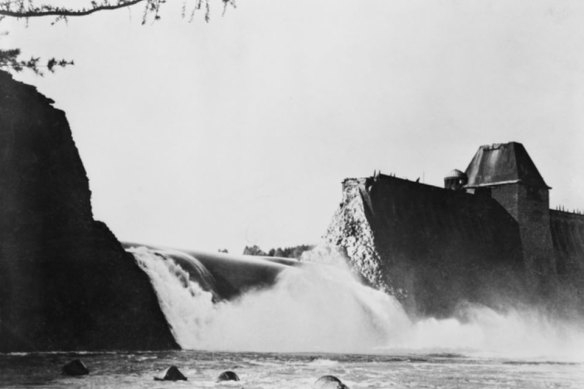Save articles for later
Add articles to your saved list and come back to them any time.
The destruction of the Kakhovka dam in Ukraine, seemingly by Russian forces, is being called the largest man-made disaster in Europe since Chernobyl in 1986, unleashing a flood of water across the war zone and putting more than 80 settlements, and 16,000 people, in danger.
Regrettably, the deliberate demolition of dams in war is far from uncommon; this is not the first time Ukraine has suffered so devastatingly.
Soviet leader Josef Stalin order the destruction of a dam in Zaporizhzhia, Ukraine in 1941.
The decision of Josef Stalin’s secret police to blow up the Zaporizhzhia dam in 1941 – only 150 kilometres away from Kakhovka and now the site of the synonymous nuclear power plant – is believed to have killed somewhere between 20,000 and 100,000 people.
It was motivated by the same intention: to stall the enemy advance. Indeed, the timing of Tuesday’s attack on Kakhovka can be no coincidence, impeding the Ukrainian counter-offensive just 24 hours after Kyiv began probing various points across the front.
In 1941, the demolition was apocalyptic. “People were screaming for help. Cows were mooing, pigs were squealing. People were climbing on trees”, one survivor recalled.
Early reports suggest there are few human casualties from Tuesday’s attack, but thousands of animals will have perished, and the environmental consequences will be felt for decades.
There are other examples of manmade floods intended to impede an army.
Perhaps the most destructive and long-lasting was in 1938, when the Chinese destroyed dykes along the Yellow River as part of their scorched-earth strategy to hamper the Japanese. It worked, but at a terrible cost: somewhere between 30,000-90,000 drowned, with as many as half a million dying from its after-effects, especially famine. The dykes were not repaired until 1947.
Another largely forgotten example took place during the Battle of the Yser in the early months of the First World War. The Belgians resisting the German invasion opened the sluices at Nieuwpoort, creating a one mile-wide floodplain which contributed to Belgium holding onto a corner of the country even when 95 per cent of it had fallen.
More importantly, it brought a close to the Race to the Sea, fatally disrupting the German’s Schlieffen Plan and arguably saving the British and French armies from a decisive defeat.
Yet the destruction of dams not only disrupts troop movements. It can play a crucial psychological role, most famously in the Dambusters Raid of May 1943, when the Möhne and Edersee dams were breached by British bombers and the Ruhr valley flooded.
Revisionists argue its military impact was negligible, but the morale boost for the Allies was huge, horrifying the Germans as to the damage relatively few British aircraft could wreak.
Russia’s apparent attack on the Kakhovka dam has shocked the people of Ukraine and troubled Europe more. Perhaps the biggest psychological consequence will be a reassessment of just how far the Russians are willing to go to achieve victory.
Water pours from the Moehre Dam six hours after the successful attack by the RAF in 1943 during World War II.Credit: Australian War Memorial
Many argued for months that the possibility of Putin triggering a nuclear incident was far-fetched.
Not now.
Indeed, Russian forces had already recklessly shelled the nuclear plant at Zaporizhzhia; yesterday they risked a major incident if the plant’s cooling system had failed due to flooding.
The EU has accused Russia of “barbaric aggression”, yet the fact is Volodymyr Zelensky warned back in October that the Russians had mined the dam and called for international observers to attend the site. Nothing was done.
He must wonder how many more times the West can be shocked by Russia’s strategy before they consider his analysis to be realistic, not fear-mongering, forged from the suffering his country has been forced to endure.
Telegraph, London
Get a note directly from our foreign correspondents on what’s making headlines around the world. Sign up for the weekly What in the World newsletter here.
Most Viewed in World
From our partners
Source: Read Full Article




